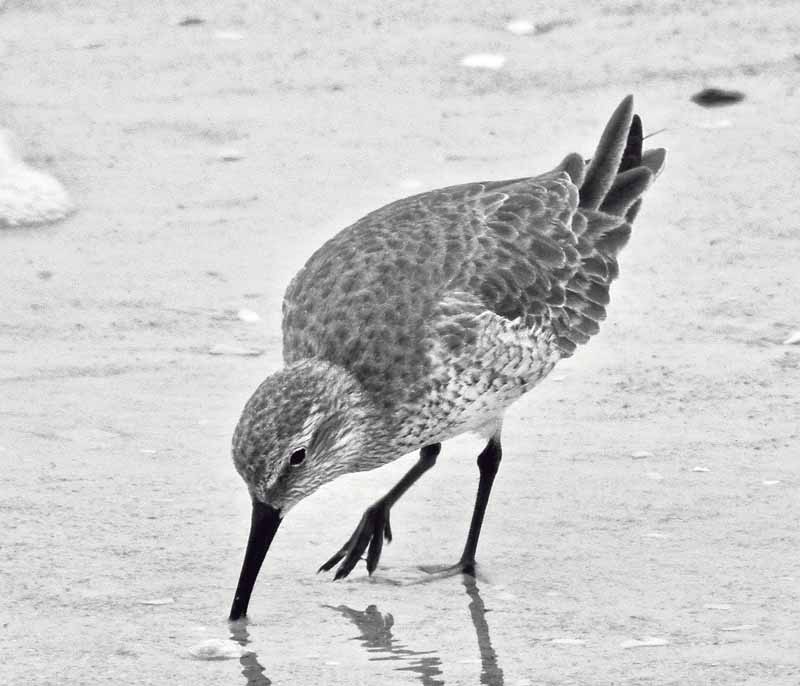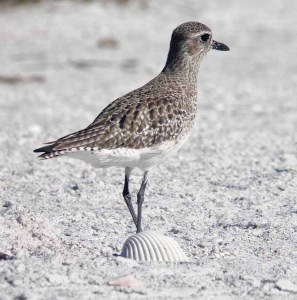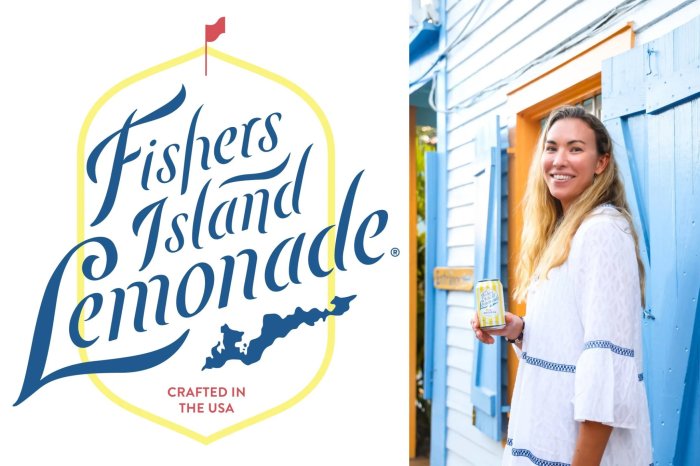
Every fall, red knots make the exhausting journey of 9,300 miles from the Arctic to the tip of South America. In the spring, they make the return trip, which is timed to coincide with a stopover at Delaware Bay when enormous numbers of tiny horseshoe crab eggs are spawning. Having lost half their weight, the red knots need those eggs to fuel up and finish their return trip to their Arctic breeding grounds. In recent years they haven’t been getting enough of those eggs due to the diminishing number of horseshoe crabs.
Last Roundup?
This winter, I’m watching these moderate-sized shorebirds that for years had come in large numbers to the beach that I walk every winter day. Last winter, they stopped; I never saw one. Their numbers had declined so precipitously between 1980 and 2006 that some predicted their extinction by 2013. In 2014, they were listed as threatened. Last winter after seeing none I believed that they were marching toward extinction.
However, in early December of 2017 I saw five on the beach. In the following days their numbers grew to 15. It may be shortsighted, but I believe what I see, therefore I’m not overly worried that the knots are on the way to eternity’s doorstep. I believe I’m looking at their persistence, not their demise. However, there’s a tension in not knowing if they are staying or going. If I’m looking at the end of the line of marchers in a parade that is passing, I want to observe them as much as I can.

Numbers Count
One morning there are 60 red knots in two groups at the north end of the beach. They’re dark masses digging fruitfully in the shallowest water and the wet sand. Their submerged bills seem to move in a shivering motion up to their bases. They appear to “chew” with bills partly opened. In actuality, they ingest hard shelled prey, including small crabs which are then crushed by powerful gizzards. When I showed images of them feeding to my wife, she noted just how deeply their bills were submerged. They have sensitive nerve endings called Herbst corpuscles in their mandibles, which allow them to sense prey.
Counting birds isn’t easy because most of the time they move. The mixed group of more than 100 red knots and willets is a problem. I guesstimate that there are about 90 red knots and the rest willets. They are thoroughly mixed together like a shuffled deck of cards. This is a large number of both birds that move up and down, back and forth, from the water to the sand, a large dark moving mass. They all fly with a sudden collective sound of wings flapping and bodies moving.
Nearby, there’s a group of 31 willets mixed in with a group of royal terns and Forster’s terns that are part of a huge assembled multitude of 400 to 500 gulls and terns. Then it strikes me that I’ve been seeing willets as well. Last year they were nonexistent to scarce here. While they are not yet threatened or endangered, their numbers too have declined since the 1960s. But they’re back too. Is there a common connection here?
The Company They Keep
Walking on a shell strewn part of the beach, I’m watching the ground directly in front of me. I’ve accidentally rousted some black-bellied plovers and seven semipalmated plovers from where they were resting. All are looking at me, but not walking away. When sanderlings comprise such a group, they are a show of bright brown and white with perhaps a flash of gold. These birds are darker, as dull looking as the sky is gray and slightly larger than sanderlings. Twenty red knots accompanied by one sanderling land on the beach and in the shallowest water to feed. I’m not just glad to see this group. It simply looks and feels like these birds are wintering here and not migrants. I wonder where they stay?
I follow a lone sanderling up the beach that is carrying a small shell and bites down hard on it. Walking back, the shoreline curves and juts out where it meets the water. The furthest spot is dark. Is it sand or a collection of peeps gathering or feeding? It’s the red knots, but I soon see that the population has doubled to 41. There are also seven more further back on the sand resting with a number of sanderlings and two black-bellied plovers. Nearby are also a group of resting semipalmated sandpipers. Suddenly, without any warning, they all fly out to the water and go left in a long line circling back to the beach 20-yards from where they had been. They march into a gully left by the high tide to feed and are joined by more who were resting. They all do a speed walk to the water, but stop and return to the gully.
A few days later, I’m looking in a long out-of-print book for the knots old time nicknames. In reading the text, which describes their behavior in the early 20th century, I come across a simple sentence stating that they feed in the company of black-bellied plovers, ruddy turnstones, dunlin and a few sanderlings. Except for the dunlin, I’ve been seeing the others but never paid any attention. But I have seen the semipalmated plovers. Does that mean anything? That red knots are feeding in the same company as 100 years ago is interesting. I don’t know what it means. However, whether or not I’m looking at a parade that’s passing, I should keep an eye on the company the red knots keep.
































